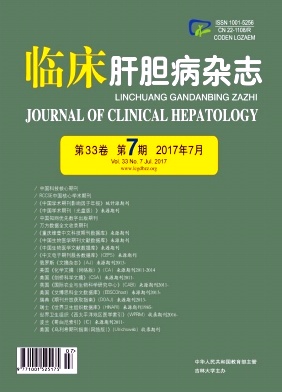|
[1]QI JH, WANG J, KATAYAMA H, et al.Circulating microRNAs (cmiRNAs) as novel potential biomarkers for hepatocellular carcinoma[J].Neoplasma, 2013, 60 (2) :135-142.
|
|
[2]VILANA R, FORNER A, GARCIA AN, et al.Hepatocellular carcinoma:diagnosis, staging, and treatment strategy[J].Radiologia, 2010, 52 (5) :385-398.
|
|
[3]KUDO M.The 2008 Okuda lecture:management of hepatocellular carcinoma:from surveillance to molecular targeted therapy[J].J Gastroenterol Hepatol, 2010, 25 (3) :439-452.
|
|
[4]OMATA M, LESMANA LA, TATEISHI R, et al.Asian Pacific Association for the study of the liver consensus recommendations on hepatocellular carcinoma[J].Hepatol Int, 2010, 4 (2) :439-474.
|
|
[5]BRUIX J, SHERMAN M, LLOVET JM, et al.Clinical management of hepatocellular carcinoma.Conclusion of the Barcelona-2000EASL Conference[J].J Hepatol, 2001, 35 (3) :421-430.
|
|
[6]BRUIX J, SHERMAN M.Management of hepatocellular carcinoma-an update[J].Hepatology, 2011, 53 (3) :1020-1022.
|
|
[7]LI P, CHEN YH, ZHANG SB, et al.Comparison of dierent hepatocarcinoma screening schemes for patients with hepatitis B associated cirrhosis:Detection rate and impact on prognosis[J].World Chin JDig, 2015, 20 (23) :3298-3303. (in Chinese) 李鹏, 陈玉涵, 张世斌, 等.乙型肝炎肝硬化患者不同肝癌筛查方案的比较及对预后影响[J].世界华人消化杂志, 2015, 20 (23) :3298-3303.
|
|
[8] Chinese Society of Hepatology and Chinese Society of Infectious Diseases, Chinese Medical Association.The guideline of prevention and treatment for chronic hepatitis B (2010 version) [J].J Clin Hepatol, 2011, 27 (1) :I-XVI. (in Chinese) 中华医学会肝病学分会, 中华医学会感染病学分会.慢性乙型肝炎防治指南 (2010年版) [J].临床肝胆病杂志, 2011, 27 (1) :I-XVI.
|
|
[9]Ministry of Health of the People's Republic of China.Diagnosis, management, and treatment of hepatocellular carcinoma[J].J Clin Hepatol, 2011, 27 (11) :1141-1159. (in Chinese) 中华人民共和国卫生部, 原发性肝癌诊疗规则 (2011年版) [J].临床肝胆病杂志, 2011, 27 (11) :1141-1159.
|
|
[10]FORNER A, REIG ME, de l OPE CR, et al.Current strategy for staging and treatment:the BCLC update and future prospects[J].Semin Liver Dis, 2010, 30 (1) :61-74.
|
|
[11]LIN SM, LIN CJ, LIN CC, et al.Randomised controlled trial comparing percutaneous radiofrequency thermal ablation, percutaneous ethanol injection, and percutaneous acetic acid injection to treat hepatocellular carcinoma of 3cm or less[J].Gut, 2005, 54 (8) :1151-1156.
|
|
[12]WANG JH, CHANGCHIEN CS, HU TH, et al.The efficacy of treatment schedules according to Barcelona Clinic Liver Cancer staging for hepatocellular carcinoma-survival analysis of 3892 patients[J].Eur JCancer, 2008, 44 (7) :1000-1006.
|
|
[13]TSENG PL, WANG JH, TUNG HD, et al.Optimal treatment increased survival of hepatocellular carcinoma patients detected with community-based screening[J].J Gastroenterol Hepatol, 2010, 25 (8) :1426-1434.
|
|
[14]KUO YH, LU SN, CHEN CL, et al.Hepatocellular carcinoma surveillance and appropriate treatment options improve survival for patients with liver cirrhosis[J].Eur J Cancer, 2010, 46 (4) :744-751.
|
|
[15]LLOVET JM, DUCREUX M, LENCIONI R.EASL-EORTC clinical practice guidelines:management of hepatocellular carcinoma[J].JHepatol, 2012, 56 (4) :908-943.
|
|
[16]STEFANIUK P, CIANCIARA J, WIERCINSKA-DRAPALO A.Present and future possibilities for early diagnosis of hepatocellular carcinoma[J].World J Gastroenterol, 2010, 16 (4) :418-424.
|
|
[17]LIN H, ZHENG WD.The diagnosis and prognostic value of AFP, AFU, TSGF and IL-8 in liver transplantation patients with liver cancer[J].J Clin Exp Med, 2017, 16 (8) :776-780. (in Chinese) 林花, 郑卫东.AFP、AFU、TSGF及IL-8对肝癌患者诊断及肝移植术预后评估的价值研究[J].临床和实验医学杂志, 2017, 16 (8) :776-780.
|
|
[18]ZHU QX.Diagnostic value of joint detection of golgin 73, alphafetoprotein, alpha-fetoprotein variants for primary hepatocellular carcinoma[J].China Med Herald, 2016, 13 (5) :130-133. (in Chinese) 诸琴红.高尔基体蛋白73、甲胎蛋白、甲胎蛋白异质体3%联合检测对原发性肝癌的诊断价值[J].中国医药导报, 2016, 13 (5) :130-133.
|
|
[19]LI JL, SHAGN J, NING HB, et al.Role of serum abnormal prothrombin protein induced by vitamin K absence or antagonist-II in development and progression of hepatocellular carcinoma[J].J Clin Hepatol, 2017, 33 (1) :171-174. (in Chinese) 李俊利, 尚佳, 宁会彬, 等.PIVKA-II在肝细胞癌诊断及预后判断中的作用[J].临床肝胆病杂志, 2017, 33 (1) :171-174.
|
|
[20]KOKUDO N, HASEGAWA K, AKAHANE M, et al.Evidence-based clinical practice guidelines for hepatocellular carcinoma:the Japan Society of Hepatology 2013 update (3rd JSH-HCC Guidelines) [J].Hepatol Res, 2015, 45 (2) :123-127.
|













 DownLoad:
DownLoad: